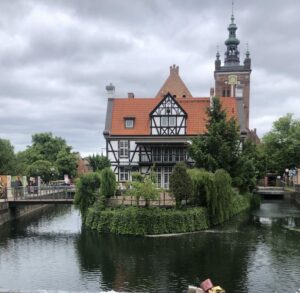Marcel Deat wrote in 1939 “Mourir pour Dantzig?”(To die for Dantzig?) expressing a classical question about any war in Europe and the World. To die for some city, some mountain,. some sea, some territory? Is it worth it? After 80 years from the last Gdansk battle, we can say long life to Gdansk, wonderfully rebuild and renovated, vibrant of people and future , transmitting light and energy to anyone visiting it, like all Poland country. A prototype of old Central Europe city with its Gothic houses, impressive cathedrals, cobbled stone narrow streets, makes you feeling at home, gives deep roots to your dreams and future desires. To walk in its Long Market Square, in the shadow of the municipality tower pointing to Baltic sky dotted of low white clouds moving with the wind, is an unforgotteble experience. You feel on your skin the centuries running, the cultures changing. You can read through the layers of different civilisations from slavic Casciubi, to Piast Polish first kings, to Teutonic Order, to Swedish occupation, to Prussian kings, to Russian Empire incumbency , to SSSR invasion, to Polish final renaissance after every partition of the country. The magnificent architecture covering so long history and heritage is from Netherlands schools, adding a further testimony of international connections of this old harbour. The Polish kings were fond of the top architectural and artistic masterpieces, calling Italians at Bona Sforza times, wife of Sygmund I in 1500, and the Flemish artists in 1600. Every Old City of Central Europe, speaks of integration of the European cultures, identifies the real Europe, not the present common market and financial construction. Of course the strategic geographic position of Gdansk was at the focus of commercial and logistic flows among all Baltic powers and all the people and languages of Europe were here along its peers in the long estuary of Vistula and cultures were meeting along with commerce and wealth.
But the favourable location was also origin of horrible facts for the population. From the massacre of people executed by Teutonic Knights trying to convert them to Christian Religion, taking also opportunity of to expand German possession, to the polish-lithuanian Union with Jagellons, to the long Great War of the North 1700-1721, Gdansk has been occupied, destroyed and rebuild with enormous people sacrifices and suffering. Unbelievable the cultural resilience pushing the city also to a period of independence between the two world wars. The Second World War started here with the German military ship Schleswig-Holstein firing on the Polish small garrison of Westerplatte at Vistula mouth in 1939 and finished with Red Army bombing and battling last German soldiers in 1945. The city was destroyed quite completely but everything has been rebuild again with the same stones, to symbolise the resistance and the deep roots of Polish culture. As a consequence of the horrible war, the German population has been pushed away and subtstituted with Polish people coming from other areas. So no one remembers that Gunther Grass the German Nobel has born here and expressed in all its books the love for this city and the tragedy of its history. Today Gdansk is a very young vibrant sea city, with an intense ‘movida’ along the harbour new dwellings and modern architectural masterpiece like the new theatre on the river. As in all the country you can see new infrastructure, here the nice airport and related highways, and in the eyes of the people joy and hopes for the future. A lot of internal tourism animate the streets in this stormy June, alternating strong winds and rains to some timid sun flashes. Probably no one want to remember the past, but stones speak loudly to the sensitive souls. It’s not a feeble suggestion, it’s a cry to restart from the past to build a real integrated European culture, to live in peace and prosperity avoiding new mortal conflicts, to start again from the immortal Hans Memling “Universal Judgment” masterpiece returned luckily to Gdansk, to conceive and design a better future.

